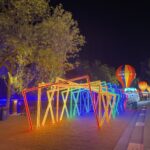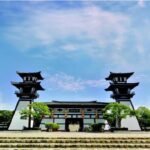Ge Yuan was built by Huang Zhijun, the ‘Salt Commissioner of Lianghuai’ (a major taxpayer of the imperial court) during the reigns of Jiaqing and Daoguang of the Qing Dynasty, on the site of the former Shouzhi Garden of the Ming Dynasty. At that time, the garden was filled with green bamboos. Because the shape of bamboo leaves resembled the character ‘个’, it was named ‘Ge’ Yuan. The four-season rockery in the garden is very distinctive.
A tour around the garden is like experiencing spring, summer, autumn and winter. Ge Yuan is not large and can be divided into three areas: the northern bamboo appreciation area, the central garden, and the southern residential area. The entire garden has three gates: the north gate for entry only, the east gate for exit only, and the south gate for both entry and exit. The south gate is on the famous Dongguan Street. Ge Yuan is not large. Whether entering from the north gate or the south gate, a tour along the north-south direction is sufficient. Compared with other famous gardens, the essence of Ge Yuan lies in the rockery and stone stacking art themed on the four seasons. Different stones are used to stack and form the four scenes of ‘spring, summer, autumn, and winter’. The four-season rockeries each have their own characteristics. When you tour the garden, you can see a stone peak standing in the sparse bamboo forest. This is the’spring scene’, symbolizing the return of spring and the revival of bamboo shoots after the rain. To the north of the spring scene is the’summer scene’, where clear water flows through the rocks, presenting a vibrant scenery. To the east of the spring scene, you can see the ‘autumn scene’. Around a pile of stacked stones, there are several maple trees, presenting a solemn autumn atmosphere. And to the south of the spring scene, near the south gate, is the ‘winter scene’. The stacked stones here are all snow-white, just like the severe winter with heavy snowfall. The four scenes of stacked stones are located in the southern part of the garden. In addition to the four-season stacked stones, taking a walk in the bamboo forest in the northern part of the garden is also a very pleasant thing. Even in the scorching summer, walking in the lush bamboo forest can feel quite cool. Tourists can hire commentators at the north gate and south gate of the garden, and charges are collected according to the number of people.Opening hours: Open all year round from 07:30 to 17:00.

Preferential policies:

Children: Children under 1.4 meters (inclusive) and under 6 years old (inclusive) are free.

Elderly: Elderly people over 70 years old (inclusive) can enter for free with their ID cards or senior citizen cards. Elderly people aged 60 (inclusive) to 70 (exclusive) can enter at a discounted price with their ID cards.
Cost: For groups of fewer than 8 people, it costs 80 yuan. The maximum cost is 180 yuan. Audio guide rental: Location: Outside the ticket office. Stroller rental: Reference price: Free. A deposit of 300 yuan is required. Location: Tourist center. Restrooms: There are multiple restrooms located near the north gate entrance and to the west of Xia Shan. Nursing room: Catering: None inside the park. There are options in the Huaju Li block. Alipay and WeChat are accepted. Convenience store: Under the Milü Corridor. Alipay and WeChat are accepted.









